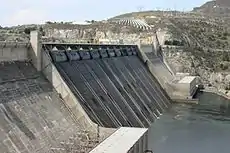Public utility
A public utility company (usually just utility) is an organization that maintains the infrastructure for a public service (often also providing a service using that infrastructure). Public utilities are subject to forms of public control and a regulation ranging from local community-based groups to statewide government monopolies.
The term utilities can also refer to the set of services provided by these organizations consumed by the public: coal, electricity, natural gas, water, sewage, telephone, and transportation. Broadband internet services (both fixed-line and mobile) are increasingly being included within the definition.[1][2][3][4]
United States
In the United States, public utilities are often natural monopolies because the infrastructure required to produce and deliver a product such as electricity or water is very expensive to build and maintain. As a result, they are often government monopolies, or if privately owned, the sectors are specially regulated by a public utilities commission.[1][2] The first public utility in the United States was a grist mill erected on Mother Brook in Dedham, Massachusetts in 1640.[5]
Developments in technology have eroded some of the natural monopoly aspects of traditional public utilities. For instance, electricity generation, electricity retailing, telecommunication, some types of public transit and postal services have become competitive in some countries and the trend towards liberalization, deregulation and privatization of public utilities is growing. However, the infrastructure used to distribute most utility products and services has remained largely monopolistic.
Public utilities can be privately owned or publicly owned. Publicly owned utilities include cooperative and municipal utilities. Municipal utilities may actually include territories outside of city limits or may not even serve the entire city. Cooperative utilities are owned by the customers they serve. They are usually found in rural areas. Publicly owned utilities are non-profit. Private utilities, also called investor-owned utilities, are owned by investors,[6][7][8] and operate for profit, often referred to as a rate of return.
Public utilities provide services at the consumer level, be it residential, commercial, or industrial consumer. In turn, utilities and very large consumers buy and sell electricity at the wholesale level through a network of regional transmission organizations (RTO) and independent system operators (ISO) within one of three grids, the Eastern Interconnection, the Texas Interconnection, which is a single ISO, and the Western Interconnection.
Public utilities commissions
A public utilities commission is a governmental agency in a particular jurisdiction that regulates the commercial activities related to associated electric, natural gas, telecommunications, water, railroad, rail transit, and/or passenger transportation companies. For example, the California Public Utilities Commission (or CPUC) [3] and the Public Utility Commission of Texas regulate the utility companies in California and Texas, respectively, on behalf of their citizens and ratepayers (customers). These public utility commissions (PUCs) are typically composed of commissioners, who are appointed by their respective governors, and dedicated staff that implement and enforce rules and regulations, approve or deny rate increases, and monitor/report on relevant activities. Over the years, various changes have dramatically re-shaped the mission and focus of many public utility commissions. Their focus has typically shifted from the up-front regulation of rates and services to the oversight of competitive marketplaces and enforcement of regulatory compliance.[9]
United Kingdom and Ireland
In the United Kingdom and Ireland, the state, private firms, and charities ran the traditional public utilities. For instance, the Sanitary Districts were established in England and Wales in 1875 and in Ireland in 1878.
The term can refer to the set of services provided by various organizations that are used in everyday life by the public, such as: electricity generation, electricity retailing, electricity supplies, natural gas supplies, water supplies, Sewage works, sewage systems and broadband internet services.[10] They are regulated by Ofgem, Ofwat and Ofcom. Disabled community transport services may occasionally be included within the definition. They were mostly privatised in the UK during the 1980s.
References
- "Public utility - Definition". Merriam-Webster Dictionary. Archived from the original on 2011-11-05. Retrieved 2011-10-11.
- "public utility definition". Investorwords.com. Archived from the original on 2011-09-28. Retrieved 2011-10-11.
- "California Public Utilities Commission". Cpuc.ca.gov. 2007-03-23. Archived from the original on 2011-10-10. Retrieved 2011-10-11.
- Ruiz, Rebecca R.; Lohr, Steve (26 February 2015). "F.C.C. Approves Net Neutrality Rules, Classifying Broadband Internet Service as a Utility". The New York Times. Archived from the original on 26 February 2015. Retrieved 8 May 2018.
- "Where Growth Centers". The Salina Evening Journal. Salina, Kansas. November 6, 1922. p. 13. Archived from the original on April 2, 2015. Retrieved March 17, 2015 – via Newspapers.com.

- "investor-owned utility (IOU), private utility, private power company". www.energyvortex.com. Archived from the original on 2 February 2017. Retrieved 8 May 2018.
- "Electric Utilities". www.utilityconnection.com. Archived from the original on 27 October 2017. Retrieved 8 May 2018.
- Pentland, William. "Investor-Owned Utilities: Asleep at the Switch or Above the Law?". forbes.com. Archived from the original on 29 July 2017. Retrieved 8 May 2018.
- "Public Utilities Commission of Texas". Public Utilities Commission of Texas. Archived from the original on 14 August 2012. Retrieved 17 February 2017.
- "Utilities Websites". Uk250.co.uk. Archived from the original on 2011-11-04. Retrieved 2011-10-11.
External links
| Look up utility in Wiktionary, the free dictionary. |
